Intel Announces 8th Generation Core "Coffee Lake" Desktop Processors: Six-core i7, Four-core i3, and Z370 Motherboards
by Ryan Smith & Brett Howse on September 25, 2017 1:00 AM EST- Posted in
- CPUs
- Intel
- Desktop
- Core 8th Gen
- Coffee Lake
- Z370

In an unusual set of circumstances (ed: someone couldn't follow a simple embargo), this evening Intel is officially announcing its 8th Generation desktop CPU lineup, codenamed Coffee Lake. This comes roughly a week and a half ahead of its originally planned launch date (and still the shipping date) of October 5th. We’ve already seen part of the 8th Generation announced – the "Kaby Lake Refresh" based mobile parts – which included a bump in core counts for some of the formerly dual-core U-series processors, upgrading them to quad-core processors with HyperThreading. Meanwhile on the desktop side, there’s been some news that’s already found its way out, and as usual, some rumors as well. But tonight, Intel is finally and officially taking the wraps off of their latest lineup of desktop CPUs, along with the associated Z370 chipset.
Although there’s a lot of new enhancements coming to the party, arguably the biggest one for most people is that Intel has finally expanded the core counts across the range, which is something they’ve not done on non HEDT systems since they originally went to quad-cores with the Core 2 Extreme QX6700, way back in 2006. If you wanted more Intel cores than four previous to now, you’d have to move to HEDT, but no longer. Core i7 is moving to six cores with HyperThreading, Core i5 is moving to six cores, and Core i3 is moving to four cores.
| Basic Specifications of Intel Core i5/i7 Desktop CPUs | |||||||||||
| 7th Generation | 8th Generation | ||||||||||
| CPU | Cores | Freq. (Base) |
Freq. (Boost) |
L3 | TDP | CPU | Cores | Freq. (Base) |
Freq. (Boost) |
L3 | TDP |
| i7-7700K ($339) |
4/8 | 4.2GHz | 4.5GHz | 8 MB | 91W | i7-8700K ($359) |
6/12 | 3.7GHz | 4.7GHz | 12 MB | 95W |
| i7-7700 ($303) |
3.6GHz | 4.2GHz | 65W | i7-8700 ($303) |
3.2GHz | 4.6GHz | 65W | ||||
| i5-7600K ($242) |
4/4 | 3.8GHz | 4.2GHz | 6 MB | 91W | i5-8600K ($257) |
6/6 | 3.6GHz | 4.3GHz | 9 MB | 95W |
| i5-7400 ($182) |
3.0GHz | 3.5GHz | 65W | i5-8400 ($182) |
2.8GHz | 4.0GHz | 65W | ||||
| i3-7350K ($168) |
2/4 | 4.2GHz | NA | 4 MB | 60W | i3-8350K ($168) |
4/4 | 4.0GHz | N/A | 8 MB | 91W |
| i3-7100 ($117) |
3.9GHz | NA | 3 MB | 51W | i3-8100 ($117) |
3.6GHz | N/A | 6 MB | 65W | ||
If you’ve got workloads that can handle more threads, the latest Coffee Lake parts should provide a significant boost in performance. We’ll have to wait for the full review to see how much of an increase this provides, but Intel is saying up to 25% more FPS and 45% better performance when “mega-tasking” compared to the Core i7-7700K. Those are fairly bold claims, so we’ll have to see how they make out, but it would not be out of the realm of possibility, especially on the “mega-tasking” where Intel is talking about gaming, plus streaming, plus recording of PlayerUnknown’s Battlegrounds, compared to the quad-core i7-7700K.
Nothing comes for free, of course, and the extra cores on the i7-8700K do push the base frequency down 500 MHz from the Kaby Lake i7-7700K, although the boost frequency is 200 MHz higher. The latter is particularly interesting, as Intel isn't using "favored cores" ala Turbo Boost Max 3.0 here. Instead, these are typical Turbo Boost 2.0 frequencies, which is to say that each and every core needs to be capable of hitting these published clockspeeds. Or put another way, if you throw TDP limits into the wind, turning on a motherboard's multi-core enhancement (or equivalent) should get you a true 4.7GHz 6-core CPU without any real overclocking. Similarly, I strongly suspect that the lower base clock is for TDP reasons, as Intel has only increased the official TDPs from 91W for the high-end 7th Gen CPUs to 95W for the 8th Gen CPUs.
Suffice it to say then, Intel is aiming for high performance levels here. This isn't something that's going to touch Intel's HEDT Skylake-X family of CPUs in heavily multi-threaded workloads simply by virtue of lower TDPs and fewer cores – though the i7-7800X has just become redundant – but instead the new hex core models in particular are going to offer Intel's fastest single-threaded performance to date, coupled with an increased number of cores. So high-end buyers will find themselves picking between fast Coffee Lake hexes, somewhat lower ST performance Skylake-X processors with 8+ cores, and of course AMD's Ryzen lineup, which has lower ST performance still, but at the high-end offers 8 to 16 Zen cores.
The downside for Intel mainstream CPU users through all of this is that prices are going up on Intel's high performance K model CPUs. Whereas the list price for a 7700K was $339, it's $359 for an 8700K, a $20 (6%) jump. Similarly, a top-end i5 has gone from $242 for the 7600K to $257 for the $8600K, a $15 (6%) price increase. And as always, keep in mind that these prices are per chip in a 1000 unit order; actual retail prices will be several percent higher still. So don't be surprised to see the 8700K closing in on $400 at retail.
Meanwhile, along with the new Coffee Lake CPUs, Intel is also announcing a new chipset to support said CPUs: Z370. Intel's specifications for motherboards require improved power delivery over the previous models, to support the higher demands of more cores. They also support DDR4-2666 memory officially now. Curiously, the slides from Intel show integrated Thunderbolt 3, which would make a lot of sense since Intel wants to promote their own standard; however the company was unable to let us know if any extra silicon would be required to enabled Thunderbolt 3 after the chipset, which was the case with the Z270. Most likely it will be, as Thunderbolt's high speeds require transceivers/redrivers close to the ports. Intel did however clarify that HDMI 2.0a will still require an extra LSPCon (Level Shifter - Protocol Converter) in the DP 1.2 path.
Intel is also promoting its Optane Memory, which is the cache version of their Optane brand. This isn’t new, and we’ve even had a chance to try out Optane Memory earlier this year. The numbers Intel quotes though are compared to an older system with a mechanical hard drive, and while Optane Memory will certainly help out there, so will moving to SSDs for your storage.
Intel is also touting the overclocking capabilities of the latest processors, which feature per-core overclocking, and other enhancements to let the end-user squeeze the last ounce of performance out of their purchase. Personally, I’m not into overclocking, so I’ll leave this section to Ian for the review.
It's hard to imagine that Intel’s Coffee Lake is quite what the company wanted to offer when drawing up their plans a couple of years ago. But with increased competition, OEMs who prefer a regular cadence they can match their own product lineups to, and most importantly the well-published delays in getting their cutting-edge 10nm manufacturing process up to par, Intel has had to stick with 14nm again. However the upshot of this is that Coffee Lake is the first CPU family coming out of Intel built on their updated 14++ process, so while it remains to be seen just how good 14++ really is, under the hood Coffee Lake is going to be at least a little bit more than just a bump in the CPU core counts.
Speaking of cores, Intel has also confirmed that relative to Kaby Lake, Coffee Lake still retains the same CPU and GPU architectures; Intel isn't rolling out any new architectural designs here. This means we're talking about Skylake CPU cores coupled with Kaby Lake GPU cores, though with what I imagine will be higher clockspeeds on the latter as well. So while Coffee Lake won't completely upend Intel's CPU stack – and this is why Intel isn't committing a massive faux pas by mixing Kaby Lake Refresh with Coffee Lake under the 8th Gen banner – a 50-100% increase in cores is hard to be upset about. The increased performance, especially in multi-threaded workloads, should help Intel in the desktop space, which is the one space where they have actual competition right now.
Source: Intel


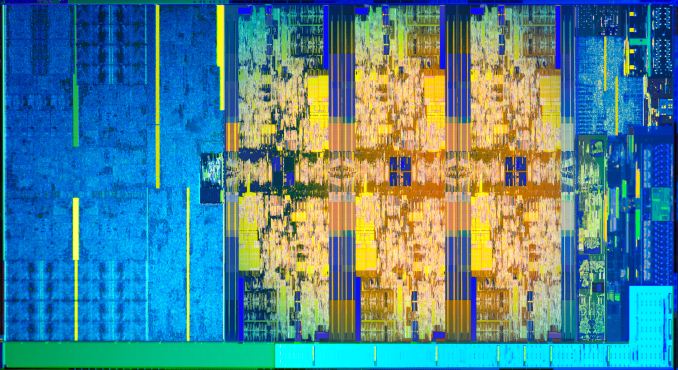
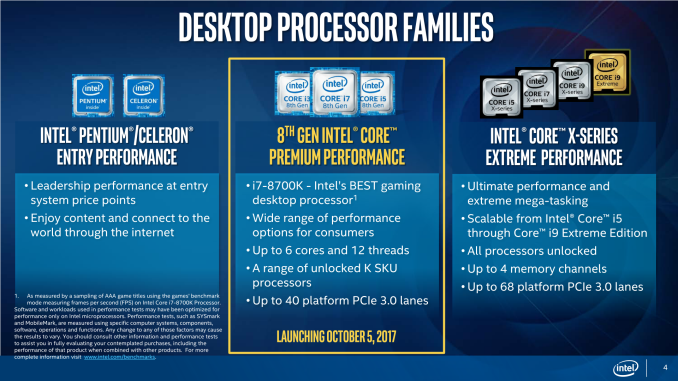
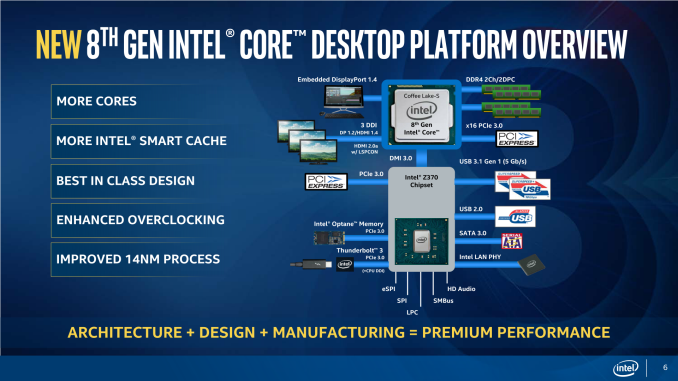
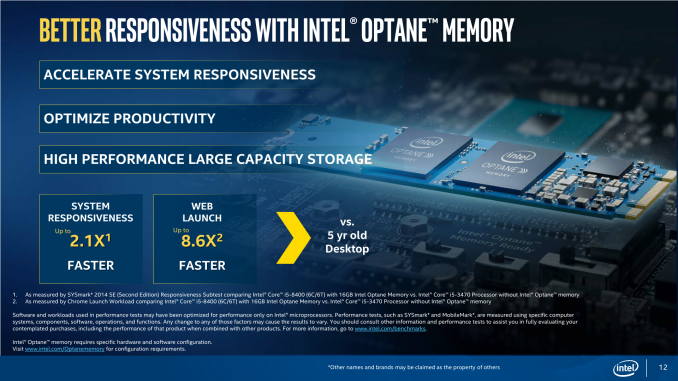
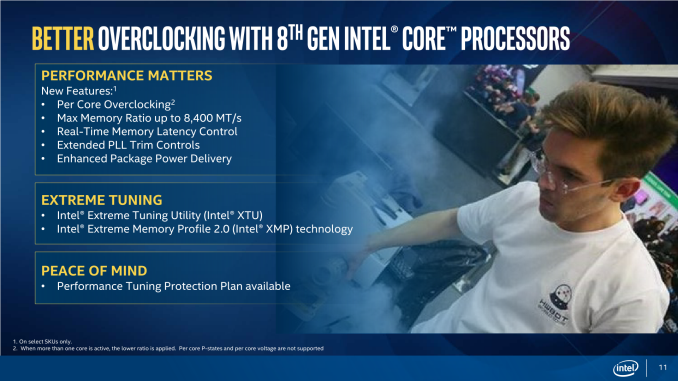
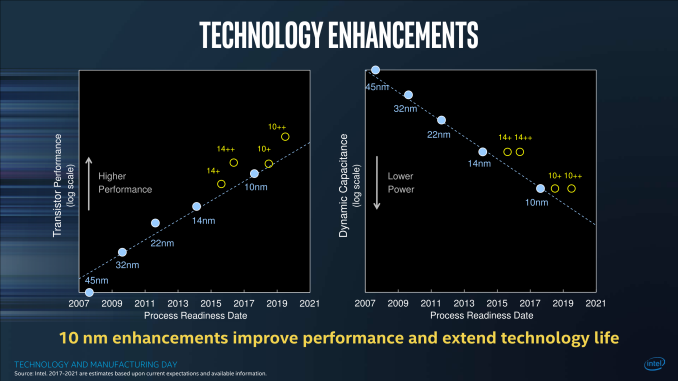














108 Comments
View All Comments
jrs77 - Monday, September 25, 2017 - link
I'll take that i7-8700 over any current AMD offering for a single reason... the iGPU.All I do doesn't require a dedicated GPU. Photoshop, Illustrator, InDesign, Dreamweaver are perfectly fine with the iGPU, as is SketchUp and Blender if you don't render anything. The additional 2 cores and 4 threads will come in handy when firing up Reason or CuBase, where i don't need any graphics-power either.
With this CPU I can build a decent workstation in a tiny 7" x 7" x 3" package, and AMD has nothing to offer for me in that area, as I'd allways need that pesky dedicated GPU.
wolfemane - Monday, September 25, 2017 - link
You must not do a whole lot of anything in photoshop, or don't mind (or even realize) the length of time to accomplish anything beyond basic tasks.jrs77 - Monday, September 25, 2017 - link
I don't do anything else for some 6-8 hours per day then to use the Adobe Suite for work and I do it perfectly fine on my iGPU. And I use Photoshop for the last 20 years allready.None of the things you do on a daily basis in Photoshop uses the GPU for anything really, neither does SketchUp or Blender in edit-mode.
Ro_Ja - Monday, September 25, 2017 - link
AMD still has the better onboard GPU in the long shot.I am just hoping they dont bottleneck their onboadd GPU like what Bristol Ridge did LOL
jrs77 - Monday, September 25, 2017 - link
The better AMD iGPU is of no interest, when the intel iGPU is working just fine. In this case it comes down to CPU-power alone, and the old AMD APUs are not even worth mentioning.The new Raven Ridge APUs will only have 4 Cores, so I don't expect much from them either.
Spunjji - Monday, September 25, 2017 - link
You listed a bunch of tasks that benefit from GPU power and do not benefit from a thermally constrained CPU, then waxed lyrical about taking that power and putting it in a box that will mean you cannot get anything like its full potential out of it.But that's cool, as it's your opinion it can't be wrong per-se... just daft.
jrs77 - Monday, September 25, 2017 - link
None of the software I use and listed does benefit from GPU-power. Photoshop only uses the GPU for scrolling, resizing, panning etc, and the intel iGPU does work just fine for this.In SketchUp and Blender edit-mode the intel iGPU is under no stress aswell. I do not render images, I just do the 3d-drawings for furniture manufacturing or 3d-printing. No GPU-power needed for that.
And thermal constraint? I have no problem running my current i7-5775C in a small box like that on full throttle.
coder543 - Monday, September 25, 2017 - link
That's not true. Photoshop uses GPU-acceleration for other tasks, when an appropriate GPU is available.Here's an article: http://www.nvidia.com/object/adobe-photoshop-cc.ht...
and the relevant quote:
"Adobe Photoshop CC takes advantage of the innovative Mercury Graphics Engine for NVIDIA GPUs to create a smooth and intuitive design experience. New GPU-accelerated features include an expanded Blur Gallery, adding even more options for stylish image blurring; Focus Mask for automatically selecting the in-focus area of a photo; and upsampling, which enables high-quality up-scaling of images like those extracted from video frames. Other key GPU features include Smart Sharpen, Liquify, and more than 30 others."
So, if you aren't using an nVidia GPU, you may only be using the GPU for scrolling and panning, but Photoshop is willing to use the GPU for more than that. I believe Photoshop also supports AMD GPUs for accelerating various tasks, and they _technically_ support some of the high-end Iris Intel GPUs, I think, but obviously a more powerful GPU will do tasks faster than a slower GPU, just like how a faster CPU is obviously faster than a slower CPU. That is how it works.
jrs77 - Monday, September 25, 2017 - link
As someone who professionally works with Photoshop for the last 20 years let me tell you, that all these fancy blur filters, focus masks and whatnot are not used by most professionals.99% of the time you really do very simple tasks in Photoshop that don't need a powerful PC to begin with. I could probably do 90% of my work on a MacBookAir just fine.
Stop reading advertising-material and go to an advertising-agency for example and actually look what people are doing the whole day in Photoshop.
mapesdhs - Monday, September 25, 2017 - link
Still sounds like an edge case. First time I've heard of someone who didn't gain from a discrete GPU for Adobe apps, and didn't render in Blender. If this is your workflow, that's fine, but you're talking about it as if your setup is typical, yet it's really not.